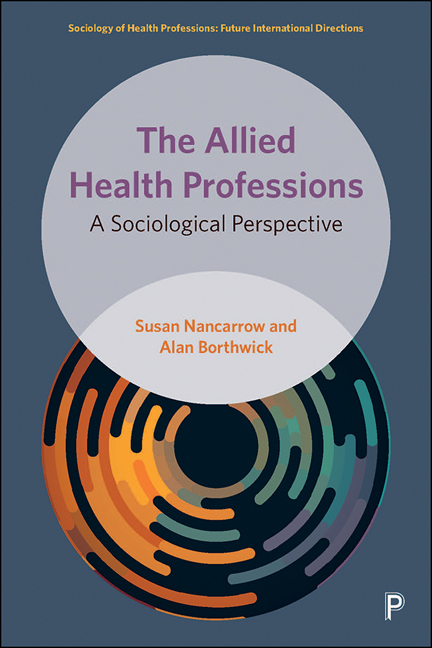Book contents
- Frontmatter
- Contents
- List of abbreviations
- Acknowledgements
- Editors’ overview
- Introduction
- 1 The allied health collective
- 2 Diversity in the allied health professions
- 3 The established allied health professions
- 4 Emerging allied health professions
- 5 The support workforce within the allied health division of labour
- 6 Specialisation in allied health
- 7 Post-professionalism and allied health
- Conclusion
- References
- Index
1 - The allied health collective
Published online by Cambridge University Press: 05 January 2022
- Frontmatter
- Contents
- List of abbreviations
- Acknowledgements
- Editors’ overview
- Introduction
- 1 The allied health collective
- 2 Diversity in the allied health professions
- 3 The established allied health professions
- 4 Emerging allied health professions
- 5 The support workforce within the allied health division of labour
- 6 Specialisation in allied health
- 7 Post-professionalism and allied health
- Conclusion
- References
- Index
Summary
This chapter examines the concept of allied health as a collective comprised of constituent professional groupings. Here, we describe the development of the allied health professions over the past century from the perspective of both the development of individual professions and the emergence of allied health under medical hegemony. Concepts that will be explored include considerations around a heterogeneous group of occupations attempting to work together to achieve a single professional project. We also examine the international health and social care organisational and policy contexts and the importance of the various regulatory frameworks.
What are the ‘allied health professions’?
The allied health professions are distinct from the medical and nursing professions in numerous ways. Collectively, allied health professions comprise approximately one third of the total health workforce. Due to large jurisdictional variations in inclusion in the allied health collective, as well as challenges in capturing allied health workforce data, the exact numbers and scale of the allied health professions vary widely and are difficult to determine accurately (Olson, 2012; Nancarrow et al, 2017).
Unlike medicine and nursing, which have strong brand recognition, large individual professional size, internal hierarchies, recognised specialisms and, importantly, a strong political voice, the allied health professions are a confederation of independent disciplines, each of varying size and focusing on a niche area of practice. Allied health professions face the dual challenge of negotiating their discrete professional territory within the boundaries of the allied health collective, while attempting to achieve recognition and a voice alongside their larger medical and nursing counterparts.
The established allied health professions share with nursing a period of growth in the 20th century that was subject to medical dominance, largely characterised by one of three modes of domination: subordination, limitation and exclusion (Turner, 1985). For Turner, these related directly to the extent to which the ‘paramedical’ professions were subject to medical authority in the form of direct instructions in practice (thus depriving the profession of autonomy), by permitting autonomy within a limited jurisdiction (to a discrete body part, such as in dentistry, or a distinct therapeutic technique, such as in pharmacy) or, indeed, by rejection of the scientific legitimacy of its claimed knowledge base (as in chiropractic).
- Type
- Chapter
- Information
- The Allied Health ProfessionsA Sociological Perspective, pp. 27 - 56Publisher: Bristol University PressPrint publication year: 2021



